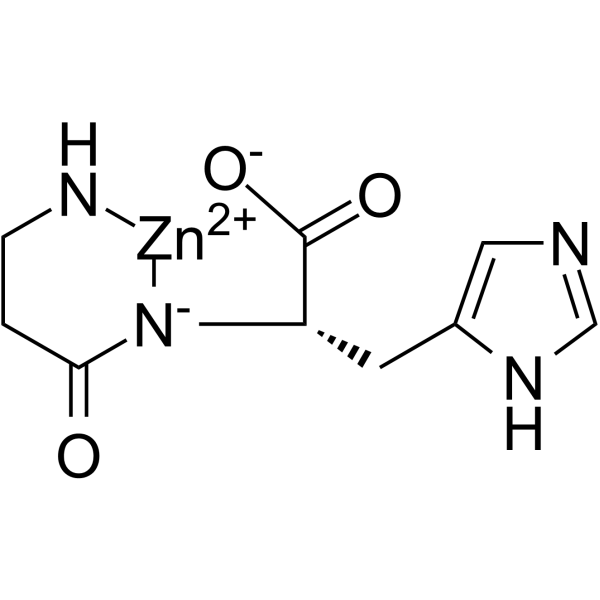| Name | Polaprezinc |
| Synonyms | Z 103 ;Promac ;Polaprezinc ;POLAPREZINC ;ZINC CARNOSINE ;zinc l-carnosine complex ;b-Alanyl-L-histidinato Zinc ;zinc n-(3-aminopropionyl)histidine ;[b-Alanyl-kN-L-histidinato(2-)-kN,kO]-zinc ;zinc 2-[(3-azanidyl-1-oxido-propylidene)amino]-3-(3H-imidazol-4-yl)propanoate |
| CAS | 107667-60-7 |
| EINECS | 600-848-7 |
| Formula | C9H11N4O3Zn |
| Molar Mass | 289.61 |
| InChI | InChI=1/C9H14N4O3.Zn/c10-2-1-8(14)13-7(9(15)16)3-6-4-11-5-12-6;/h4-5,7H,1-3,10H2,(H,11,12)(H,13,14)(H,15,16);/q;+2 |
| Structure |  |
| Density | |
| Melting Point | >300°C |
| Boiling Point | 177.5°C |
| Flash Point | |
| Water Solubility | |
| Vapor Pressure | |
| Refractive Index | |
| Specific Rotation | |
| Use | Polyprizine is a new anti-ulcer drug developed by Japan's Hamari New Drug Co., Ltd. It is the first zinc-containing compound used in clinic. The drug was launched in Japan under the trade name Promac in 1994, and the dosage form is granule. polypryzine is an L-carnosine zinc complex. L-carnosine is a dipeptide composed of β-alanine and L-histidine. It is an antioxidant; zinc can promote wound healing. Clinical experimental data show that poly (zinc) has the effect of anti-oxidation and membrane stability, so as to maintain the balance of gastric mucosa and protect gastric mucosal cells. At the same time, it can also promote wound healing, enhance the effect of defense factors, and achieve the prevention and treatment of peptic ulcer. |
| Physical and Chemical Properties | Solubility:Aqueous Acid (Slightly) Appearance:White crystal Color:White to Off-White Storage Condition:Refrigerator Toxicity:LD50 in male, female mice, rats (mg/kg): 220, 165, 405, 422 i.p.; 758, 874, >5000, >5000 s.c.; 1269, 1331, 8441, 7375 orally (Matsuda) |
| Safety Description | |
| Risk Codes | |
| Hazard Symbols |
